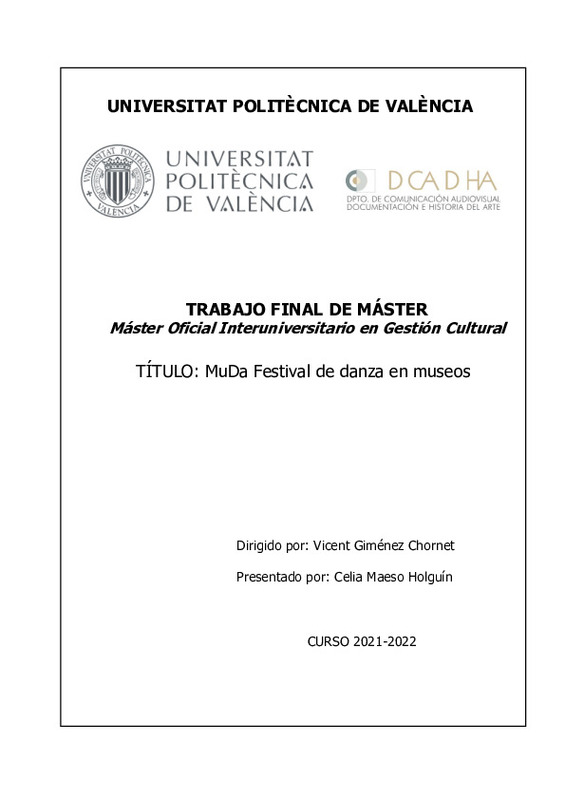JavaScript is disabled for your browser. Some features of this site may not work without it.
Buscar en RiuNet
Listar
Mi cuenta
Estadísticas
Ayuda RiuNet
Admin. UPV
Desarrollo del turismo cultural en Guizhou para dar a conocer a la minoría étnica Miao
Mostrar el registro sencillo del ítem
Ficheros en el ítem
| dc.contributor.advisor | Mestre i Mestre, Eva María
|
es_ES |
| dc.contributor.author | Li, Jiaxin
|
es_ES |
| dc.coverage.spatial | east=106.70722; north=26.5981999; name=HPX4+7V Yunyan District, Guiyang, Guizhou, Xina | es_ES |
| dc.date.accessioned | 2024-09-10T08:53:18Z | |
| dc.date.available | 2024-09-10T08:53:18Z | |
| dc.date.created | 2024-07-25 | |
| dc.date.issued | 2024-09-10 | es_ES |
| dc.identifier.uri | http://hdl.handle.net/10251/207875 | |
| dc.description.abstract | [ES] Cuando se trata de destinos de viaje en China, muchos optan por ciudades cosmopolitas como Shanghai y Beijing, o las pintorescas zonas costeras, a menudo pasando por alto las ricas tradiciones de las minorías étnicas, como los Miao. Este antiguo grupo étnico se encuentra disperso por toda China, principalmente en las provincias de Guizhou, Hunan, Hubei, Sichuan, Yunnan. Según registros históricos e historias transmitidas oralmente, los antepasados de los Miao vivían originalmente en la región media y baja del río Amarillo. Posteriormente, emigraron al sur y al oeste debido a conflictos bélicos y otros factores, estableciéndose en las montañas del suroeste y en la meseta de Yunnan-Guizhou. La ropa tradicional Miao es notablemente variada, con motivos que incluyen dragones, fénix, flores y otros elementos de la naturaleza. Además, cuentan con un rico patrimonio cultural inmaterial, como el batik, el bordado Miao y el brocado Tujia. Entre las celebraciones más destacadas se encuentra el Festival del Tambor Zang, que se celebra cada trece años y representa una importante ceremonia de veneración a los antepasados. La cultura juega un papel fundamental en el desarrollo del turismo, enriqueciendo la experiencia de los visitantes y añadiendo profundidad a la vida cultural de la región. Combinar el patrimonio cultural inmaterial de los Miao con el turismo no sólo resalta la singularidad de su cultura, sino que también crea oportunidades para el desarrollo económico y la promoción del entendimiento intercultural. Por lo tanto, este estudio se centra en analizar el patrimonio y el desarrollo del patrimonio cultural inmaterial de los Miao, así como en explorar la integración de este rico patrimonio cultural con la industria del turismo, creando atracciones turísticas destacadas. | es_ES |
| dc.description.abstract | [EN] When it comes to travel destinations in China, many opt for cosmopolitan cities such as Shanghai and Beijing, or the picturesque coastal areas, often overlooking the rich traditions of ethnic minorities, such as the Miao. This ancient ethnic group is scattered throughout China, mainly in the provinces of Guizhou, Hunan, Hubei, Sichuan, Yunnan. According to historical records and orally transmitted stories, the ancestors of the Miao originally lived in the middle and lower Yellow River region. Later, they migrated south and west due to war conflicts and other factors, settling in the southwest mountains and the Yunnan-Guizhou plateau. Traditional Miao clothing is remarkably varied, with motifs including dragons, phoenixes, flowers and other elements of nature. In addition, they have rich intangible cultural heritage, such as batik, Miao embroidery and Tujia brocade. Among the most notable celebrations is the Zang Drum Festival, which is held every thirteen years and represents an important ceremony of veneration of ancestors. Culture plays a fundamental role in the development of tourism, enriching the experience of visitors and adding depth to the cultural life of the region. Combining the intangible cultural heritage of the Miao with tourism not only highlights the uniqueness of their culture, but also creates opportunities for economic development and the promotion of intercultural understanding. Therefore, this study focuses on analyzing the heritage and development of intangible cultural heritage of the Miao, as well as exploring the integration of this rich cultural heritage with the tourism industry, creating outstanding tourist attractions. | es_ES |
| dc.format.extent | 49 | es_ES |
| dc.language | Español | es_ES |
| dc.publisher | Universitat Politècnica de València | es_ES |
| dc.rights | Reserva de todos los derechos | es_ES |
| dc.subject | Minoría étnica Guizhou Miao | es_ES |
| dc.subject | Patrimonio cultural intangible | es_ES |
| dc.subject | Turismo cultural | es_ES |
| dc.subject | Patrones de bordado. | es_ES |
| dc.subject | Guizhou Miao ethnic minority | es_ES |
| dc.subject | Intangible cultural heritage | es_ES |
| dc.subject | Cultural tourism | es_ES |
| dc.subject | Embroidery patterns. | es_ES |
| dc.subject.classification | FILOLOGIA INGLESA | es_ES |
| dc.subject.other | Grado en Turismo-Grau en Turisme | es_ES |
| dc.title | Desarrollo del turismo cultural en Guizhou para dar a conocer a la minoría étnica Miao | es_ES |
| dc.title.alternative | Development of Cultural Tourism in Guizhou to Promote the Miao Ethnic Minority | es_ES |
| dc.title.alternative | Desenvolupament del Turisme cultural a Guizhou per a conéixer a la minoria ètnica Miao | es_ES |
| dc.type | Proyecto/Trabajo fin de carrera/grado | es_ES |
| dc.rights.accessRights | Abierto | es_ES |
| dc.contributor.affiliation | Universitat Politècnica de València. Departamento de Lingüística Aplicada - Departament de Lingüística Aplicada | es_ES |
| dc.contributor.affiliation | Universitat Politècnica de València. Escuela Politécnica Superior de Gandia - Escola Politècnica Superior de Gandia | es_ES |
| dc.description.bibliographicCitation | Li, J. (2024). Desarrollo del turismo cultural en Guizhou para dar a conocer a la minoría étnica Miao. Universitat Politècnica de València. http://hdl.handle.net/10251/207875 | es_ES |
| dc.description.accrualMethod | TFGM | es_ES |
| dc.relation.pasarela | TFGM\161466 | es_ES |
Este ítem aparece en la(s) siguiente(s) colección(ones)
-
EPSG - Trabajos académicos [5004]
Escuela Politécnica Superior de Gandia









